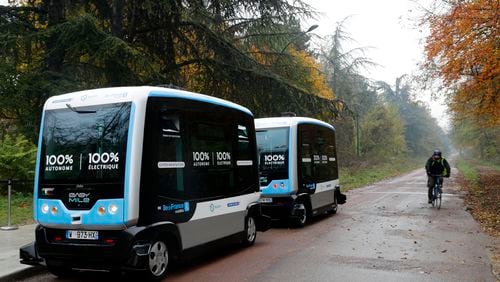You’re crossing the street wrong.
That is essentially the argument some self-driving car boosters have fallen back on in the months after the first pedestrian death attributed to an autonomous vehicle and amid growing concerns that artificial intelligence capable of real-world driving is further away than many predicted just a few years ago.
These technologists say the problem isn’t that self-driving cars don’t work, it’s that people act unpredictably.
“What we tell people is, ‘Please be lawful and please be considerate,’” says Andrew Ng, a well-known machine learning researcher who runs a venture fund that invests in AI-enabled companies, including self-driving startup Drive.AI. In other words: no jaywalking.
Whether self-driving cars can correctly identify and avoid pedestrians crossing streets has become a burning issue since March after an Uber self-driving car killed a woman in Arizona who was walking a bicycle across the street at night outside a designated crosswalk. The incident is still under investigation, but a preliminary report from federal safety regulators said the car’s sensors had detected the woman but its decision-making software discounted the sensor data, concluding it was likely a false positive.
Google’s Waymo has promised to launch a self-driving taxi service, starting in Phoenix, Arizona, later this year, and General Motors Co. has pledged a rival service-using a car without steering wheel or pedals-some time in 2019. But it’s unclear if either will be capable of operating outside of designated areas or without a safety driver who can take over in an emergency. Meanwhile, other initiatives are losing steam. Elon Musk has shelved plans for an autonomous Tesla to drive across the U.S. Uber has axed a self-driving truck program to focus on autonomous cars. Daimler Trucks, part of Daimler AG, now says commercial driverless trucks will take at least five years. Others, including Musk, had previously predicted such vehicles would be road-ready by 2020.
With these timelines slipping, driverless proponents like Ng say there’s one surefire shortcut to getting self-driving cars on the streets sooner: persuade pedestrians to behave less erratically.If they use crosswalks, where there are contextual clues-pavement markings and stop lights-the software is more likely to identify them.
But to others the very fact that Ng is suggesting such a thing is a sign that today’s technology simply can’t deliver self-driving cars as originally envisioned. “The AI we would really need hasn’t yet arrived,” says Gary Marcus, a New York University professor of psychology who researches both human and artificial intelligence. He says Ng is “just redefining the goalposts to make the job easier,” and that if the only way we can achieve safe self-driving cars is to completely segregate them from human drivers and pedestrians, we already had such technology: trains.
Rodney Brooks, a well-known robotics researcher and an emeritus professor at the Massachusetts Institute of Technology, wrote in a blog post critical of Ng’s sentiments that “the great promise of self-driving cars has been that they will eliminate traffic deaths. Now [Ng] is saying that they will eliminate traffic deaths as long as all humans are trained to change their behavior? What just happened?”
Ng argues that humans have always modified their behavior in response to new technology, especially modes of transportation. “If you look at the emergence of railroads, for the most part people have learned not to stand in front of a train on the tracks,” he says. Ng also notes that people have learned that school buses are likely to make frequent stops and that when they do, small children may dart across the road in front of the bus, and so they drive more cautiously. Self-driving cars, he says, are no different.
The industry is understandably keen not to be seen offloading the burden onto pedestrians. Uber and Waymo both said in emailed statement that their goal is to develop self-driving cars that can handle the world as it is, without being dependent on changing human behavior.
Eventually, better computer vision systems and better AI may solve this problem. Cities will probably remake themselves for an autonomous age with “geofencing,”creating separate zones and designated pickup spots for self-driving cars and taxis. In the meantime, your parents’ advice probably still applies: Don’t jaywalk and look both ways before crossing the street.






